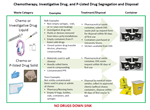Guidance for Specific Types of Waste
Learn about proper waste storage and disposal for specific waste types.
-
Aerosol Cans
Aerosol cans are a container in which gas under pressure is used to aerate and dispense any material through a valve in the form of a spray of foam. There are two different categories of aerosols in the hazardous waste program: food-related & all other types.
Food-related aerosols can be thrown directly into the trash. There is no regulated disposal for these.
All other types of aerosols must be given to and disposed of by EHS. Common examples at MSU include paint, adhesives, lubricants, pesticides, cleaners, electronic dusting sprays, expanding foam sealers, and air fresheners. Each aerosol can must be prepared in such a way to prevent a release. The two most common ways are to remove the nozzle or leave the protective cap on top of the can. Other requirements include:
- Accumulation onsite is limited to 90-days from start date.
- Containers used to collect aerosol cans onsite must be labeled with the words “Used Aerosol Cans” and a start date. Container labels can be found on EHS’s website in the WASTE section.
- Stored away from heat sources.
- Leaking or damaged aerosol cans must be packaged separately and with absorbents.
Puncturing aerosols should not be performed on campus, because an Air Permit from the Michigan Department of Environment, Great Lakes, and Energy would be required.Collect empty aerosol cans in a container labeled "Hazardous Waste: Used Aerosol Cans Only." When full, submit a Hazardous Waste Pickup request via the EHS Safety Portal.
- Animal Material (Bedding and PPE)
-
Batteries
Alkaline batteries: discard in the general refuse. They are not harmful to the environment and the cost of actual recycling far outweighs the benefit.
Nickel/cadmium, lithium ion or nickel nydride, lead acid, and mercury or silver oxide batteries: Collect used batteries, segregated by type, in any container labeled with the words "used batteries" or "spent batteries for recycling." To prevent a buildup of heat or sparks, batteries larger than 9-volt should be stored such that the terminals are not touching. Submit a Hazardous Waste Pickup request via the EHS Safety Portal within one year of start of collection.
-
Biological Waste, Sharps
Request Pickup
For biological waste pickup, submit a Hazardous Waste Pickup request via the EHS Safety Portal.
Guides
Postings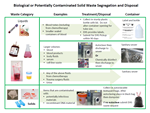
Biological or Potentially Contaminated Solid Waste Poster (PDF)
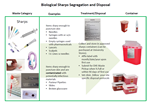
-
Broken Glass
Broken glass should be collected in a container or box that can be sealed and placed into the general refuse dumpster when full. The words “Broken Glass” should be written on opposing sides of the container.
If the broken glass is grossly (i.e. large deposits of material on glass) contaminated with any of the following compounds, submit a hazardous waste request in the EHS Safety Portal using “Hazardous Waste Solid” under the Waste Container category. Make sure to put the contaminants of concern in the description as well as on the hazardous waste tag.
-
Bulbs: Fluorescent, LED, Incandescent, etc.
Collect used tubes in the same boxes they were shipped in, if possible, labeled with the words "Used Electric Lamps." The box must be labeled when tubes are first added. Leave all flaps intact so that proper closure can be made when the box is full. Store in an area protected from weather and where breakage will not occur. Completely seal box when full.
Tubes must be picked up within one year of start of collection. Call the recycling hotline at 355-1723 to request pickup.
If older, mercury-containing tubes break prior to being sealed in a used electric lamp box, they must be collected and handled as a hazardous waste. Put the broken glass and powder in a bucket with a lid and mark the bucket as you would any other hazardous waste. For broken tubes, submit a Hazardous Waste Pickup request via the EHS Safety Portal.
-
Chemical Waste
Request Pickup
-
Chemical Waste (more than 50 containers)
If you have more than 50 bottles of chemical reagents, prep solutions, or samples to clear out of a lab:
- Ensure all materials are properly labeled.
- If materials are in the original manufacturer’s bottle with an intact and legible label, the item does not need a hazardous waste tag attached.
- If the material is a prep solution, mixture or sample, it must be properly identified and labeled with a completed hazardous waste tag indicating the contents.
- If the material is an unknown, please see additional EHS guidance for unknowns listed here before submitting materials for pick up.
- If the amount of containers for pick up is >50 bottles, please put the chemicals in an Excel Spreadsheet format that includes: PI name, building and room number, contact information, chemical name, quantity and size of containers, and submit the spreadsheet to hazwaste@msu.edu. A member of the EHS Waste Group will contact you to coordinate the removal.
- Chemotherapy, Investigative Drugs, or P-Listed Drugs
-
Contaminated Lab Debris
If the chemical you are using is listed on the back of the Hazardous Waste tag (D004-D043 or 001S-007S), OR the Safety Data Sheet (SDS) has the chemical identified as a carcinogen, then collect the contaminated laboratory debris for hazardous waste disposal through EHS. In addition, EHS will collect any contaminated debris associated with a chemical spill cleanup. Make sure when filling out the waste tag that the concentration of the chemical is noted in the right-hand column.
-
Controlled Substances
If there is excess material at the completion of research, the registrant/licensee or an authorized agent must contact Environmental Health and Safety (355‐0153) to arrange for disposal via a DEA approved method. All controlled substances must be kept secure until an appropriate disposal method can be arranged.

-
Equipment (Freezers, Ovens, Refrigerators, Glassware)
EHS and MSU Surplus Store and Recycling Center require that many items, including refrigerators, freezers, laboratory glassware, and biosafety cabinets are are decontaminated by the equipment owner prior to pick up by Surplus. An Equipment Release Form (PDF) must be completed by the equipment owner and affixed to each item given.
See MSU Surplus Store and Recycling Center's acceptance guidelines for more information.
-
Empty Bottles
- 5-gallon metal containers – these can be air dried and submitting to EHS for hazardous waste pick up. Please note, the lid must be on the container for pick up.
- P-Listed Chemicals – if your chemical is on this list, the bottle must be triple rinsed and the rinsate collected in a hazardous waste container prior to disposal in the general refuse.
- Pyrophoric Chemicals – MSU EHS will take empty and unwanted pyrophoric reagent containers as hazardous waste. Do not quench the material, remove the seal, or puncture the septum. Ensure the container is in good condition, including the cap, and is labeled as to its contents. Wrapping the outside of the cap with a layer of Parafilm is also recommended. If you are concerned about the integrity of the container do not remove any questionable containers from an inert atmosphere glovebox and contact EHS Hazardous Waste staff to consult prior to requesting a pickup.
- Reactive Chemicals – MSU EHS will take empty and unwanted reactive reagent containers as hazardous waste. Do not quench the material, remove the seal, or puncture the septum. Ensure the container is in good condition, including the cap, and is labeled as to its contents. Wrapping the outside of the cap with a layer of Parafilm is also recommended. If you are concerned about the integrity of the container contact EHS Hazardous Waste staff to consult prior to requesting a pickup. If you are disposing of any of the following pure alkali metals or alkaline earth metals, materials must be under mineral oil prior to EHS picking up the material: Sodium, Potassium, NaK, Lithium, Cesium, Rubidium, Francium, Beryllium, Magnesium, Calcium, Strontium, Barium, Aluminum, and Zinc.
- Solvents – if your chemical is a solvent, the container can be air dried in the fume hood, and once the label is defaced, it can be disposed of in the general refuse with the cap off.
- Other – if your material is not listed above, the container can be rinsed with a slight amount of water and collected in the waste container. The bottle can then be put in the general refuse with the cap off.
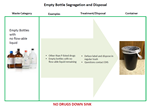
-
Gas Cylinders
If the cylinder is not returnable to the company it was purchased from, and you have made sure that there is no rental fee associated with the cylinder, submit a Hazardous Waste request for pick up in the EHS Safety Portal.
-
Lasers
Laser transfer/disposal must be facilitiated by contacting the EHS Laser Safety Officer. For more information see the Laser Safety Program.
-
Light Ballasts
All light ballasts should be collected for disposal through EHS. Ballasts should be collected in containers labeled as used or spent ballasts. If ballasts are leaking, they should be individually wrapped in plastic to prevent a spread of any potentially harmful fluid. Submit a Hazardous Waste Pickup request via the EHS Safety Portal to pick up ballasts.
-
Paint Related Debris
Empty latex paint cans (no free liquid or sludge) and dry tools and rags can be placed in general refuse.
Wet acrylic/epoxy tools, rags, solvents, thinners must be placed in a labeled container and disposed of through EHS. Submit a Hazardous Waste Pickup request via the EHS Safety Portal to pick up acrylic/epoxy paint.
-
Pathological Waste
Request Pickup
For incineration waste pickup, submit an Incineration Pickup request via the EHS Safety Portal.
-
Peroxide Formers
If any of the following conditions exist, do not open the bottle and contact EHS immediately:
- visual inspection of the material identifies crystal formation, solids, or cloudiness
- container has a metal screw cap or glass stopper
- Class A compound is past its expiration date
Provided the above conditions do not exist, the material must be peroxide tested within 24 hours of requesting waste pickup, and the results of that test noted on the label or the hazardous waste tag as follows:- The date it was received
- The date it was opened
- The date it was tested
- The testing level
If material is not tested prior to EHS picking up the material, it will not be accepted by EHS and the department may have to pay for a contractor to come on-site and remove the waste.For additional resources see the peroxide formers webpage.
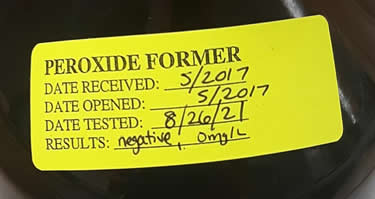
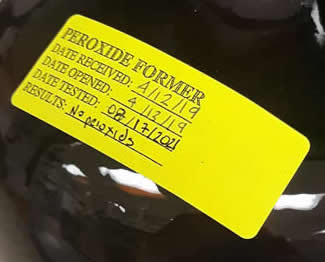
Examples of properly labeled peroxide formers ready for pickup -
Pesticides (more than 50 containers)
If you have a large quantity (more than 50 containers) of unused, expired pesticides to get rid of, send a request to hazwaste@msu.edu with an estimate of the quantity of the material, including if materials are solid, liquid, or in cylinders. Also include the PI, building and room number, and contact information on the spreadsheet. A member of the Hazardous Waste staff will contact you to coordinate disposal.
-
Piranha Solution
Piranha solution should always be collected in a plastic waste container, and never in a glass bottle due to risk of overpressurization. The caps on the containers may be slightly loose (i.e. 1 turn of the cap) to allow for off gassing. A waste request for disposal can be submitted after the piranha solution has sat for a week with no additional material added to the volume.
-
Radioactive Waste
For information on radioactive waste, see the MSU Radiation Safety Manual (PDF).
Request Pickup
For radioactive waste pickup, submit a Rad Waste Pickup request via the EHS Safety Portal. -
Unknown Materials, Samples
EHS has established protocols and guidance for managing unknown materials. Laboratories should attempt to identify unknown materials into chemical family names as a minimum, because certain materials, including mercury, polychlorinated biphenyls, dioxins, polyfluoroalkyl substances, and furans require special waste disposal procedures. If materials cannot be properly identified, the department may incur costs related to analysis and disposal.



